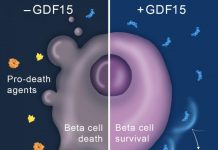A synthetic antioxidant developed by researchers at National Jewish Medical and Research Center improves the survival of islet cells used in transplants for diabetes. The findings, reported in the August issue of the journal Diabetes by researchers at the University of Pittsburgh, could help overcome a significant drawback of the "Edmonton Protocol," a promising treatment for diabetes.
"The antioxidant neutralizes the harmful free radicals generated when islet cells are isolated from the pancreas," said senior author Jon Piganelli, Ph.D., assistant professor of Pediatrics at the Diabetes Institute, Children's Hospital of Pittsburgh, and the University of Pittsburgh School of Medicine. "More of the islet cells survived in culture. And when we transplanted islet cells into diabetic, immunodeficient mice, it took fewer of the antioxidant-treated islet cells to normalize their blood sugar."
In type 1 diabetes, a person's immune system mistakenly attacks and destroys islet cells that secrete insulin necessary for the metabolism of sugar. Many diabetes patients take insulin shots to make up for the lost islet cells. In 2000, researchers from Edmonton, Alberta, reported new techniques that have made islet-cell transplantation a promising option for patients with type 1 diabetes. It allows patients to produce their own insulin. Patients have to take immunosuppressive drugs to prevent rejection of the transplants, but they maintain better control of their insulin levels, thus reducing the chances of future complications. They also avoid the daily insulin injections. Clinical trials of the "Edmonton protocol" are being conducted at several medical centers around the nation.
One drawback to the Edmonton protocol is that pancreata from at least two donors are needed to supply enough islet cells for one successful transplant. Many cells die during isolation and shortly after transplantation. Since islet cells also rapidly die in culture, surgeons are forced to transplant the cells immediately after they have been isolated. This prevents physicians from taking several steps that could improve the likelihood of a successful transplant.
Isolation of the islet cells from the pancreas stresses them, leading to inflammation and islet-cell death. Highly reactive free-radical molecules contribute to this stress. Dr. Piganelli and his colleagues reasoned that an antioxidant compound might help islet cells survive and improve transplant success by neutralizing the free radicals.
Continue Reading Below ↓↓↓
The researchers used two synthetic antioxidants developed several years earlier by Dr. James Crapo, M.D., Chairman of the Department of Medicine at National Jewish, and his colleagues. The antioxidants, dubbed AEOL10113 and AEOL10150, mimic the naturally occurring antioxidant superoxide dismutase, but are effective against a wider range of oxygen radicals and last longer in the body. Now licensed by Incara Pharmaceuticals Corporation, they have shown promise in preventing damage to cells caused by stroke and radiation therapy for cancer. Earlier this year, Dr. Piganelli and his colleagues showed that the antioxidants could prevent the development of type 1 diabetes in mice when given T cells that normally causes the disease.
"We are excited that these synthetic antioxidants are protecting cells in such a wide range of hazardous conditions," said Dr. Crapo.
Islet-cell loss was cut in half over a six-day period, from 60% to 30%, when the antioxidants were applied during isolation of the islet cells. The antioxidants also improved the effectiveness of the islet-cell transplants. When large amounts of islet cells (700-1,000 islet equivalents) were transplanted into six diabetic mice, all the animals became healthy. But when smaller amounts of islet cells (200-220 islet equivalents) were transplanted into nine diabetic mice, half the mice who got untreated islet cells remained diabetic while all the animals with antioxidant-treated islet cells returned to full health.
"The antioxidant-treated cells are healthier when they are transplanted into the mice and survive better after the transplant," said Dr. Piganelli. "We think it may be worthwhile to use the antioxidant during preservation of the pancreas, before the isolation begins, and after transplantation."
Source: National Jewish News









